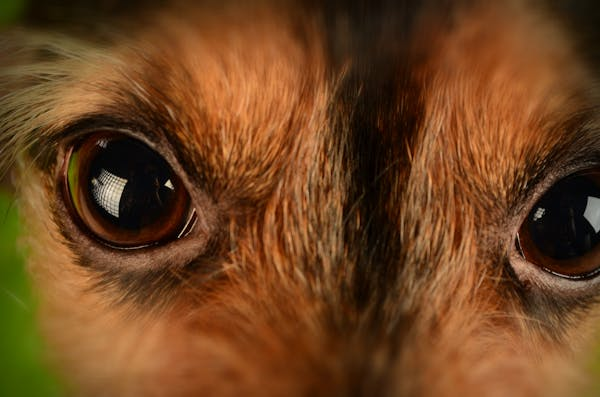You and your dog are enjoying a typical playful day at home—tossing toys, playing on the floor, and sharing fun moments. But between the laughter and games, you notice something unusual: a hint of redness in your dog’s eyes that suddenly raises concern.
You’re wondering, “why are my dog’s eyes red?”. This guide will give you details on why this might be the case. It is important to make sure that you read through this guide carefully before deciding on the best course of action. At Under The Weather, we believe that your pet’s health is always a priority. Best of all, we want to ensure you stay on top of their health needs, no matter what stage they are in their life. Let’s go over the details on what could be causing eye redness in your dog and what to do.
Is Redness in Dog Eyes Normal?
It’s true that eye redness can signal minor irritation. This is true for both humans and dogs. Typically, this can be triggered by dust, pollen, or even a lengthy sleep. It’ll eventually dissipate over time. However, if eye redness doesn’t go away and tends to persist or get worse, this is an issue that needs to be addressed promptly.
In a perfect world, if a dog is having eye issues, they would speak to us in a language we humans understand. Since they don’t, we spend time figuring out what problems they might be dealing with. However, noticing redness in the eyes is a signal that something is going on, whether it’s a mild inflammatory issue or something more serious. This addresses the question of “why are my dog’s eyes red” at the surface, but let’s delve a little deeper into the common reasons.
Why Are My Dog’s Eyes Red: Common Causes
Being able to pinpoint the issue will give you peace of mind knowing what to do next. What exactly could be triggering eye redness in your dog? Let’s take a look at the following common causes:
Allergies
Of course, eye redness is one of the common symptoms you’ll see with allergies. Many environmental irritants, such as pollen, dust, mold, and even food ingredients, are to blame here. Also, ingredients in dog grooming products are potential culprits as well. If you notice eye redness after a grooming appointment, for example, it might be due to a shampoo or cleaning product that contains a specific ingredient.
With that said, you’ll want to pay attention to the signs of allergic red eyes in dogs. These include the following:
- Watery eyes or excessive tearing
- Sneezing, itchy ears or paws
- Squinting or rubbing their face with their paws
If your dog has not been previously diagnosed with allergies, it is important to schedule an appointment with your vet. Antihistamines are considered one of the common solutions, but your vet will determine which ones are safe for dogs. Aside from that, consider changing up their diet and requesting that a groomer use hypoallergenic products for cleaning. Under The Weather also offers its Allergy and Itch Powder for Dogs, which will provide them with allergy relief and better immune support.
Conjunctivitis (Pink Eye)
Yes, it is the same kind of pink eye humans get. This is inflammation within the tissue of the eyelids and the eye itself. It also includes other symptoms such as eye discharge (which will either be clear, yellow, or green), squinting, and excessive blinking. Conjunctivitis is typically caused by allergies, but viruses, bacteria, and other irritants can also play a role.
Depending on the cause of the issue, your vet can prescribe medicated eye drops and/or topical medications like ointments. It is important that your dog not be in contact with other dogs, as conjunctivitis can be contagious.
Dry Eye
Scientifically known as keratoconjunctivitis sicca (KCS), this is an issue where your dog’s tear glands are unable to produce an adequate amount of moisture. The tears that are produced are created for a purpose: to protect the eyes. Without them, it will lead to the eyes becoming dry, irritated, and red. Dry eye is common in breeds such as Cocker Spaniels, Shih Tzus, and Bulldogs, so be sure to monitor their eyes regularly if you own any of these breeds.
Specifically, you’ll want to look out for the following signs: red eyes, thick and sticky discharge, cloudy corneas, and frequent blinking. Daily prescription drops (or artificial tears) from your vet are the best treatment option since they can replace lost moisture while stimulating tear production. It should also be noted that dry eye that is left untreated can lead to a more serious issue, such as vision loss.
External Irritants or Foreign Objects
Asking yourself, “why are my dog’s eyes red?” comes down to this answer: something is irritating them. This can include things in your immediate environment, such as dirt, smoke, cleaning products, or even grass seeds. Something, indoor or outdoors, might be triggering irritation in your dog’s eyes. If you have a dog that loves sticking their head out of your car window or explores a lot outdoors, this can be a common issue.
If you notice eye redness from recent exposure to irritants or foreign objects, it is important to treat it accordingly. Start by rinsing the eye gently with pet-safe saline. Monitor any additional issues that may arise, including squinting or pawing at the face for a few hours. If there are persistent symptoms, it is important to see your vet as soon as possible.
It should also be noted that human eye drops should not be used on dogs without vet approval. Over-the-counter products may contain ingredients that can harm pets.
Infection (Bacterial or Viral)
Typical signs for eye infections will include intense redness, discharge, and swelling. Such infections can be bacterial, viral, or fungal infections. Aside from this, there are other symptoms that you’ll want to look out for, including:
- Discharge that is like mucus
- Redness in one or both eyes
- Sensitivity to light
- Swelling around the eyelids
The infection can be treated with oral medications like antibiotics or prescription eye drops. Your vet will need to properly diagnose the infection to determine the treatment. Schedule an immediate appointment to treat the infection promptly. Without proper medical treatment, the infection can get worse or spread.
Injury or Trauma
If your dog roughhouses, has experienced an accidental poke from a stick, or has gotten a scratch from another dog, there’s a chance that an eye injury may have happened. Be on the lookout for eye trauma signs, including sudden redness or squinting, excessive blinking or pawing, eyelid swelling, or blood in the eye.
Eye injuries should be treated as an emergency situation, especially if it’s a minor issue. Schedule an immediate vet appointment for prompt treatment.
Cherry Eye
This is another eye issue typical in breeds like Cocker Spaniels, Bulldogs, and even Beagles. In this condition, a “third eyelid” gland appears as a fleshy, red mass in the corner of the eye. It’s not painful, but if untreated, it can lead to long-term issues.
Surgical intervention is the only option to correct this issue. It is important that you schedule this with your vet as soon as it is confirmed that your dog has cherry eye.
Glaucoma
Glaucoma is a serious eye condition caused by a buildup of fluid within the eye, leading to increased intraocular pressure and potential damage to the optic nerve. This health issue requires immediate attention, as it can result in permanent blindness if left untreated. In addition to eye redness, signs of glaucoma may include a bulging eyeball, a cloudy cornea, and noticeable vision loss—such as bumping into objects.
Glaucoma is a serious issue, to the point where it can be considered a medical emergency requiring immediate attention. It is important that you call your vet to begin a proper diagnosis and treatment.
How to Keep Your Dog’s Eyes Healthy
Prevention is key when it comes to eye issues that your dog might face. Thus, it is important to take the necessary measures to improve and maintain their eye health. This includes the following:
- Regular eye checks will be important. Do this especially during a grooming appointment. Look for any redness, cloudiness, or any suspicious discharge.
- Gently clean your dog’s eyes regularly with a damp cloth. Alternatively, use vet-approved wipes to remove any gunk sitting around the eye. Wipe outward from the eye, not towards it.
- Use doggy goggles if you are taking your dog on a walk, especially in areas where it can get dusty and windy. This is key for those with breeds that are prone to common eye issues.
- When using cleaning products, strong perfumes, or smoking, please keep such irritants away from your dog. The farther they are away from them, the better.
- Eye health can be preserved with the right diet. Consider feeding them foods that are rich in nutrients like omega-3 fatty acids. Supplements through Under The Weather that support eye health are also recommended.
Final Thoughts
Eye redness in dogs is something that you’ll want to investigate further. Be sure to be on the lookout for any signs of potential conditions that may arise. If the issue appears serious, then it may be a good idea to contact your vet as soon as possible. Nevertheless, taking the eye health of your dog seriously is something that you’ll want to consider doing on a regular basis.




